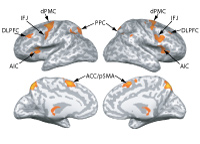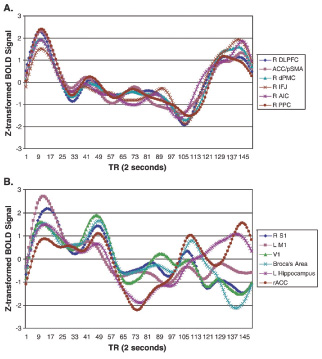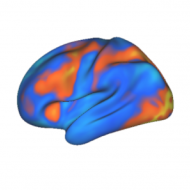 I recently published my first primary-author research study (Cole & Schneider, 2007).
I recently published my first primary-author research study (Cole & Schneider, 2007).
The study used functional MRI to discover a network of brain regions responsible for conscious will (i.e., cognitive control). It also revealed the network’s specialized parts, which each uniquely contribute to creating the emergent property of conscious will.
I believe this research contributes substantially to our understanding of how we control our own thoughts and actions based on current goals. Much remains a mystery, but this study clearly shows the existence of a functionally integrated yet specialized network for cognitive control.
What is cognitive control? It is the set of brain processes necessary for goal-directed thought and action. Remembering a phone number before dialing requires cognitive control. Also, anything outside routine requires cognitive control (because it’s novel and/or conflicting with what you normally do). This includes, among other things, voluntarily shifting attention and making decisions.
What brain regions are involved? A mountain of evidence is accumulating that a common set of brain regions are involved in cognitive control. We looked for these regions specifically, and verified that they were active during our experiment [see top figure]. The brain regions are spread across the cortex, from the front to the back to either side. However, it’s not the whole brain: there are distinct parts that are involved in cognitive control and not other behavioral demands. We defined the cognitive control network as the parts of the brain active during a line search task. This task involves remembering a target line orientation, attending to each probe line orientation, and making a decision about whether each probe is what is being looked for. We then looked at spontaneous neural activity during rest periods to measure how the network’s regions are connected.
We found that the control network is very well connected (correlation value: R=0.74). The network is much better connected than it is with the rest of the brain (R=0.49).
Also, we found that the control network is better connected with itself than the whole cerebral cortex is connected with itself on average. This means that the brain regions supporting high-level control of thought and action are highly integrated! (Though it’s also interesting to note that the cortex is, on average, much more connected than chance; R=0.40).
This figure shows how the control network’s slow-wave activities (over 5 minutes) act in unison (A), relative to other brain regions specialized for motor, visual, language, memory, somatosensory, and emotional functions (B):

Neuroscientists have had a hard time understanding how two especially well-connected brain regions (DLPFC and ACC/pSMA) are specialized. DLPFC is located in the prefrontal cortex, on the upper lateral portion (see first figure). ACC/pSMA is located in the middle front of the brain (also in the first figure).
We showed that DLPFC and ACC/pSMA are highly connected (R=0.72), as expected. However, we found that DLPFC is involved in maintaining goal information over delay periods (like remembering how much money is in your wallet just after looking). ACC/pSMA, however, is involved in preparing for an especially difficult decision (like preparing to decide which of two purchases to make).
Both regions were involved in decision making. This is likely because the decisions involved remembered material (from DLPFC) which was more engaged when the decision was more difficult (as detected by ACC/pSMA).
In the experiment, participants built habitual responses to certain line orientations as targets. It was especially hard to decide not to perform these habitual responses once they were no longer correct (due to a target change). The current goal (maintained in DLPFC) had to increase its influence in order to overcome the tendency to respond to these stimuli.
Generalizing to an economic decision: The contents of one’s wallet, and the goal to buy the best music player given those contents, would combine as each music player is evaluated. Any tendency to purchase a music player that’s too expensive would, in theory, engage ACC/pSMA, which would in turn drive the goal representation (your intention to stay within budget) in DLPFC to alter behavior. Some of us are, of course, better at this kind of self-control than others. Could this be because of differences in this brain circuit?
Understanding the cognitive control network is of utmost importance. The large number of situations involving cognitive control makes this obvious. If we ever hope to understand ourselves this brain circuitry must be accurately characterized. Practical applications would be forthcoming, of course, for everything from depression (controlling our emotions) to obsessive-compulsive disorder (controlling our actions/thoughts) to artificial intelligence (allowing computers to control themselves). Cole & Schneider (2007) is one step toward these lofty ends.
-MWCole
COLE, M., SCHNEIDER, W. (2007). The cognitive control network: Integrated cortical regions with dissociable functions. NeuroImage, 37(1), 343-360. DOI: 10.1016/j.neuroimage.2007.03.071

Interesting study, good work!
I wonder if you’re familiar with Randy O’Reilly’s computational theory of cognitive control. It’s incomplete, and more work like yours needs to be done to extend our understanding. However, this theory is important because a) it works at a lower, more mechanistic level, and b) because it’s closely based on evidence from several different levels of research.
Just wondering what the rest of the community thinks of the type of work coming out of our lab. In the interest of full disclosure, I’m a postdoc in Dr. O’Reilly’s lab. I think the type of work his lab is doing is has an important role in figuring out how cognitive control works, along with empirical studies such as your own.
Yes, I am very familiar with Dr. O’Reilly’s work and am a big fan. I especially like the idea of dopamine and basal ganglia signals controlling prefrontal cortex during goal selection. It really gets us close to truly vanquishing the homunculus.
I looked a bit at what was happening in basal ganglia during cognitive control (in the study described in this post) and wasn’t able to make a whole lot of sense of it. The head of the caudate nucleus showed some (inconsistent) increases during cognitive control. I wasn’t able to find a clear interpretation, though I may need a dataset with a better encoding-period manipulation to better test O’Reilly’s theories.
One thing about O’Reilly’s model that has been unclear to me is how the dopamine/BG system received inputs in order to predict reward. Is there a feedback loop from prefrontal cortex, or do sensory stimuli directly impinge on VTA/basil ganglia?